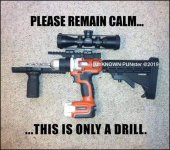7STUD - Well, all kinds of people hold different points-of-views about all kinds of things in life.
We have a couple of things going on here, which we need to be clear on:
1. The Center Ball 'roll-over' Replace the Object Ball's exact former position shot -
not slightly behind that point, nor slightly off to the side of that point, left or right, nor slightly beyond that point in space, nor left spinning on it's vertical axis - is designed as a training exercise with which to teach a student how to:
a) Hit the dead center of the CB consistently; and,
b) Create a stroke where no true stroke exists; and,
c) Learn to feel the maximum speed that shot need be hit at various distances to come perfectly to rest after a 1/2 rotation of the CB to take up the exact space where the OB once was; and,
d) Learn the unique sound and feel of a perfectly struck Center Ball hit.
2. Bringing the CB to any final position using a "fully-sliding CB"
is not this shot - for in this shot, the CB needs to contact the OB
just after the point where Slide begins to transition into Perfectly Rolling - and, with only enough 'roll' allowed to develop and residually manifest in the CB as 1/2 ball diameter rotation as the CB comes to it's resting position - which is the mechanic which brings the CB to perfectly occupy the space formerly occupied by the OB;
And,
3. Unlike the list of other shot/techniques which you have listed above -
being those are shots/techniques used in play to achieve specific CB locations and influence on the OB as it travels to the target pocket in actual position-play - the shot we are discussing is not designed for that end purpose (See #1 above); it is a training exercise shot.
A different animal and end-goal and purpose completely, when compared to the shots/techniques you've cited.
While it matters not, I believe any and all action imparted to the CB
which remains present as an influencing force at the time of a collision, will be partially transferred to and manifest on the OB; while the remaining residual force not lost to collision and transference, will also manifest itself as an equal and opposite reaction on the CB in determining it's final position in space until and when it finally comes to rest.
Therefore, if we presume the above statement to be true, and we also assume that your statement is equally true -
yet obviously, both statements cannot be true at the same time - I would then have to ask myself:
"How could a CB in motion come to rest after a collision with an OB to perfectly replace and occupy the exact physical space previously occupied by that OB, without the effects of any residual horizontal/vertical axial imbalances in pressure altering the final resting position of the CB - to a position anywhere OTHER than that which the OB perfectly occupied prior to collision?".
Not wishing to discuss Classical Mechanics of Physics, nor argue opinions, let me instead simply ask you this:
Question: Have you attempted to perform the shot exactly as Bert Kinkister demonstrates this shot in the link provided above and achieved the same successful result as he does; and, more importantly, can you then replicate those same results -
and precise finish OB/CB replacement positions - while imparting axial influences on the CB upon execution, as your position of disagreement states?
Your answers to the above tests should prove most illuminating.
Which are precisely two of the things -
See item # 1A above - which the Center Ball 'roll-over' Replace the Object Ball's position shot/exercise is specifically designed to help cure -
as there is no residual horizontal axial spin manifest in the shot we are discussing.
Good luck, if you decide to give this training shot some time on your table; and here is the link to the shot again:
Bert Kinister, Center Ball 'roll-over' Replace OB training shot - GJ
